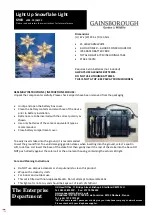
4.2.2 ALARM CHECK:
Close the cylinder valve and continue to breathe normally. Monitor pressure gauge and listen for the
whistle to activate as the gauge needle enters into the red zone (Figure 15). Open cylinder valve
fully.
4.2.3
Take two to three deep breaths to ensure you are getting adequate air into the facepiece. The
facepiece should not move towards your face.
4.2.4 BYPASS CHECK:
The red bypass knob is located on the right side of the CDV. Turn the bypass knob clockwise to
open the bypass valve. A constant flow of air should pass into the facepiece. Turn the knob in the
opposite direction to turn the bypass valve off.
4.2.5 RE-CHECK CYLINDER PRESSURE
Check the pressure gauge on the right shoulder harness. The gauge should read above 90% full
(more than halfway between 3/4 and full). Breathe normally and proceed as planned.
5.0
DURING USE
5.1
NORMAL USE
5.1.1
Monitor cylinder pressure during use for remaining air supply and allow sufficient time to exit
the contaminated area.
5.1.2
The End-of-Service-Time indicator (whistle alarm) activates when the there is approximately
25% of the air supply from a full cylinder remaining. Exit when alarm activates.
14
NOTE
It is not necessary to perform a negative pressure user’s seal check because the CDV, facepiece
and hood are designed as positive pressure assemblies.
If any of the safety checks noted above fail, DO NOT PROCEED. Remove the apparatus from
service, tag and return it for repair by authorized personnel.
Use of the optional bypass in non-emergency situations will substantially reduce the duration of
the apparatus.
The bypass will not function if the cylinder is out of air.
WARNING
The user should have received training on how to handle a possible emergency before entering
a hazardous area.
CAUTION
Содержание FRONTIER Series
Страница 27: ...27 ...













































